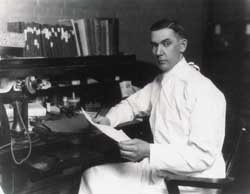 A giant in the field of nutritional science, ELMER VERNER McCOLLUM (pictured) was credited by his peers as the greatest single contributor to the improvement of human health through nutrition. The first chairman of the School of Public Health’s Biochemistry Department, Dr. McCollum was the first to use rats in nutritional experimentation. He discovered vitamin A in 1913 and co-discovered vitamin D in 1921. These findings helped him demonstrate the relationship between nutritional deficiencies and clinical symptoms of disease. As a result of his work, childhood rickets, caused by a vitamin D deficiency, quickly disappeared in America. His dedication to research and teaching was equaled by his commitment to improving public awareness of the benefits of good nutrition. He helped bring about profound changes in the American diet by contributing regular columns on nutrition to McCall’s magazine between 1922 and 1946.
A giant in the field of nutritional science, ELMER VERNER McCOLLUM (pictured) was credited by his peers as the greatest single contributor to the improvement of human health through nutrition. The first chairman of the School of Public Health’s Biochemistry Department, Dr. McCollum was the first to use rats in nutritional experimentation. He discovered vitamin A in 1913 and co-discovered vitamin D in 1921. These findings helped him demonstrate the relationship between nutritional deficiencies and clinical symptoms of disease. As a result of his work, childhood rickets, caused by a vitamin D deficiency, quickly disappeared in America. His dedication to research and teaching was equaled by his commitment to improving public awareness of the benefits of good nutrition. He helped bring about profound changes in the American diet by contributing regular columns on nutrition to McCall’s magazine between 1922 and 1946.
E.V. McCollum Professorship and Chair in Biochemistry and Molecular Biology
Bloomberg School of Public Health
Biochemistry and Molecular Biology
Established in 1967 by Burton McCollum in honor of his brother
Held by Ashani T. Weeraratna
 ASHANI T. WEERARATNA, PhD, is the E.V. McCollum Chair of Biochemistry and Molecular Biology at the Johns Hopkins School of Public Health, a Bloomberg Distinguished Professor, and Co-Program Leader of the Cancer Invasion and Metastasis Program at the Sidney Kimmel Comprehensive Cancer Center, Johns Hopkins School of Medicine. Prior to joining Johns Hopkins, she was the Ira Brind Professor and Co-Program Leader, Immunology, Microenvironment & Metastasis Program Member at the Wistar Institute. Born in Sri Lanka and raised in Southern Africa, Weeraratna first came to the United States in 1988 to study biology at St. Mary’s College of Maryland. She earned a Ph.D. in Molecular and Cellular Oncology at the Department of Pharmacology of George Washington University Medical Center. From 1998 to 2000, she was a post-doctoral fellow at The Sidney Kimmel Comprehensive Cancer Center at Johns Hopkins Oncology Center, before joining the National Human Genome Research Institute as a staff scientist. In 2003, she moved to the National Institute on Aging, where she started her own research program, before joining the Wistar Institute from 2011-2019.
ASHANI T. WEERARATNA, PhD, is the E.V. McCollum Chair of Biochemistry and Molecular Biology at the Johns Hopkins School of Public Health, a Bloomberg Distinguished Professor, and Co-Program Leader of the Cancer Invasion and Metastasis Program at the Sidney Kimmel Comprehensive Cancer Center, Johns Hopkins School of Medicine. Prior to joining Johns Hopkins, she was the Ira Brind Professor and Co-Program Leader, Immunology, Microenvironment & Metastasis Program Member at the Wistar Institute. Born in Sri Lanka and raised in Southern Africa, Weeraratna first came to the United States in 1988 to study biology at St. Mary’s College of Maryland. She earned a Ph.D. in Molecular and Cellular Oncology at the Department of Pharmacology of George Washington University Medical Center. From 1998 to 2000, she was a post-doctoral fellow at The Sidney Kimmel Comprehensive Cancer Center at Johns Hopkins Oncology Center, before joining the National Human Genome Research Institute as a staff scientist. In 2003, she moved to the National Institute on Aging, where she started her own research program, before joining the Wistar Institute from 2011-2019.
Dr. Weeraratna is an expert in melanoma metastasis, Wnt signaling, and aging, and her research focuses heavily on the effects of the tumor microenvironment on metastasis and therapy resistance. She is one of the first to study how the aging microenvironment guides metastasis and therapy resistance in melanoma. Her studies encompass biophysical changes that affect the ability of both tumor and immune cells to migrate, that affect vasculature integrity thus dictating routes of metastasis, and also secreted changes that drive metastatic signaling and response to therapy. The Weeraratna laboratory has also undertaken a global analysis of how the aged microenvironment promotes metastasis, using a unique resource of normal skin fibroblasts from healthy donors of differing ages, proteomics analysis, and animal models. The clinical implications of these data may also result in a change in clinical practice, as they are finding age-related differences in responses to both targeted and immunotherapy. Dr. Weeraratna is using these proteomics data to guide further studies on how the aging microenvironment affects tumor dormancy and cellular metabolism.
Through speaking engagements and social media, Dr. Weeraratna diligently promotes skin safety, from urging proper sunscreen use to regular mole checks, as well as the dangers of indoor tanning. She is also a fierce champion of and a mentor for junior faculty, women and people of color in science.